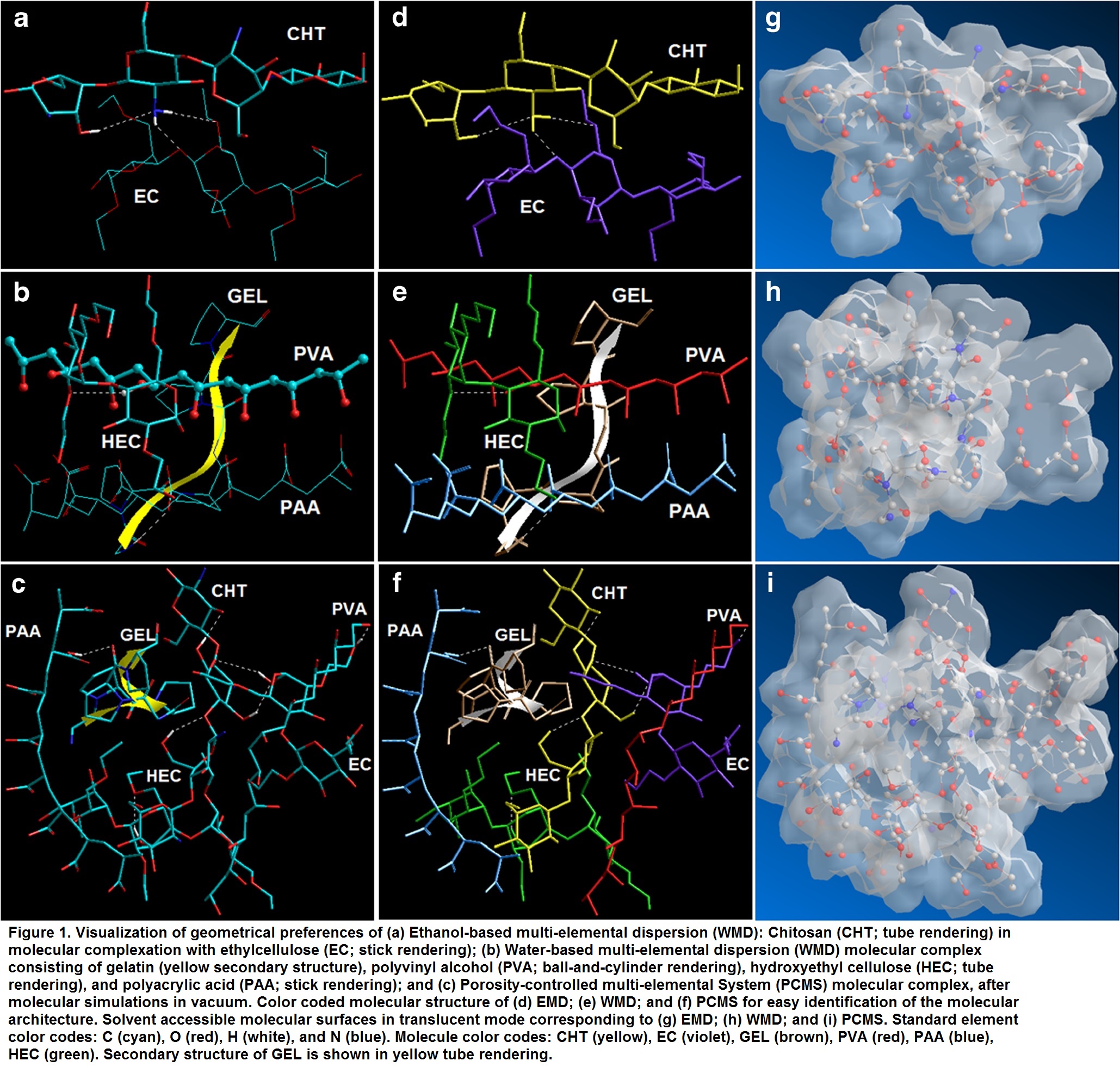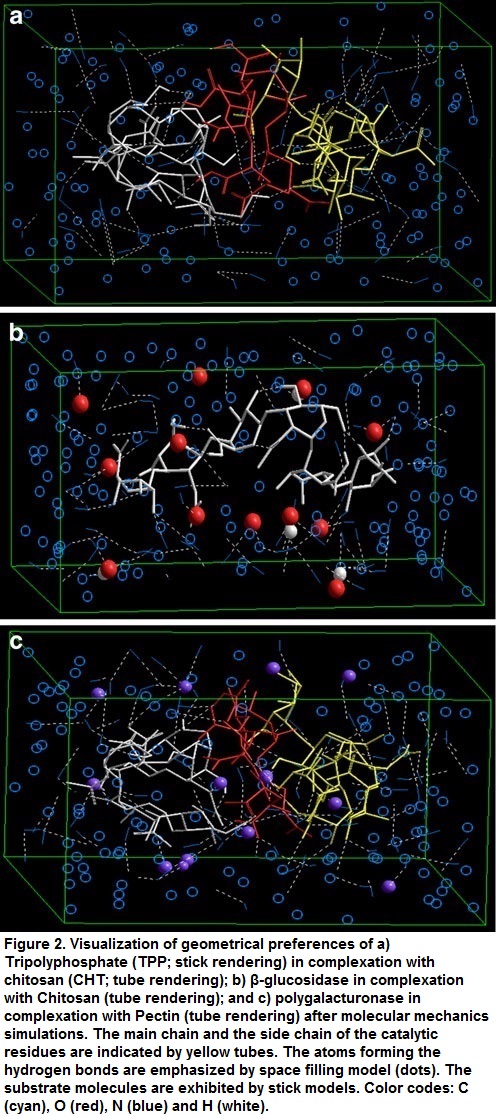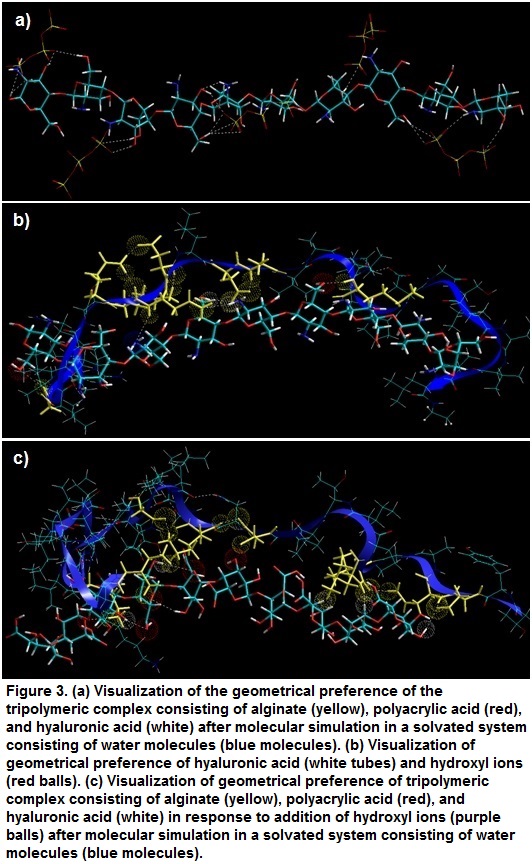Introduction: The elucidation of mechanism(s) behind the performance of biomaterial-based complex assemblies presents a significant challenge to scientists around the world with most of the studies only providing “qualitative estimation” based on “theoretical experience” and “quantitative experimental results”. Since 2011, we have employed static-lattice atomistic simulations for the “quantitative elucidation” of the mechanism inherent to multi-elemental biomaterial archetypes and have developed a unique “in vitro–in vivo–ex vivo–in silico” performance-correlation profile (first-in-the-world) of various drug delivery systems and tissue engineering scaffolds.
Methods: HyperChemTM 8.0.8 and ChemBio3D Ultra 11.0 were employed for 3D Structure generation wherein the molecular structures were drawn in their syndiotactic stereochemistry and natural angle conformation. The overall steric energy was minimized through MM+, AMBER 3 and MMFF94 force fields in conjugation with Polak–Ribiere conjugate gradient method (novel progressive convergence strategy). An analytico-mathematical representation of potential energy surfaces was designed with total energy composed of bond stretching, angle, and torsional contributions as bonding and van der Waals interactions, H-bonding and electrostatic functions as non-bonding energies. The reactional profiles for component molecules and their complexes were elucidated by exploring the spatial disposition of the various component molecular attributes.
Results and discussion: The talk will present our 10 most recent and important molecular tectonic findings related to: 1) porosity-controlled multi-elemental transbuccal system (published on Pharmaceutical Research cover page)[1];

2) catalytic action of enzymes on stimuli-synchronized alloy-treated biomatrix[2];

3) nanoformation and solvation properties of the surfactant-emulsified polymeric systems[3]; 4) nano-tensile mechanical properties of drug-plasticized macro/nano fibers (novel phenomenon)[4],[5]; 5) rheological properties of PEG-enclatherated polymethacrylate-based memblet system[6]; 6) anti-inflammatory and bioresponsive behavior of an biocomposite intraocular implant[7],[8];

7) formation of interpolyelectrolyte, hydrated and crosslinked polymer morphologies[9],[10]; 8) chelating surface-engineered ligand-bound nanoliposomes[11]; 9) interfacially plasticized electro-responsive and -activated hydrogel (PEiGOR theory)[12]; and 10) biomacromolecular interactions of an interpenetrating proteo-saccharide hydrogel network (biomaterial-protein interactions)[13],[14].
Conclusion: To date we have successfully demonstrated and published the role of molecular mechanics energy relationships towards the interpretation and understanding of the mechanisms that control the formation, fabrication, selection, design, performance, complexation, interaction, sterospecificity, and preference of various multi-elemental biomaterial archetypes for biomedical applications.
National Research Foundation (NRF) of South Africa
References:
[1] Adeleke OA, Choonara YE, du Toit LC, Kumar P, Pillay V. Pharmaceutical Research (2015) 32:2384–2409
[2] Bawa P, Choonara YE, du Toit LC, Kumar P, Ndesendo VM, Meyer LC, Pillay V. Journal of Controlled Release (2013) 166:234–245
[3] Choonara YE, Pillay V, Ndesendo VM, du Toit LC, Kumar P, Khan RA, Murphy CS, Jarvis DL Colloids and Surfaces B: Biointerfaces (2011) 87:243– 254
[4] Johnston D, Kumar P, Choonara YE, du Toit LC, Pillay V. Journal of the mechanical behavior of biomedical materials (2013) 23:80–102
[5] Shaikh RP, Kumar P, Choonara YE, du Toit LC, Pillay V. Biofabrication (2012) 4:025002
[6] Cooppan S, Choonara YE, du Toit LC, Kumar P, Ndesendo VMK, Pillay V. Journal of Applied Polymer Science (2013) 128:4327–4338
[7] du Toit LC, Govender T, Carmichael T, Kumar P, Choonara YE, Pillay V. Journal of Pharmaceutical Sciences (2013) 102:2780–2805
[8] du Toit LC, Carmichael T, Govender T, Kumar P, Choonara YE, Pillay V. Pharmaceutical Research (2014) 31:607-634
[9] Moodley K, Choonara YE, Kumar P, du Toit LC, Pillay V. Expert Opinion on Drug Delivery (2015) 12(5):693-713
[10] Ngwuluka NC, Choonara YE, Kumar P, du Toit LC, Khan RA, Pillay V. Journal of Biomedical Materials Research Part A (2015) 103A:1077–1084
[11] Mufamadi MS, Choonara YE, Kumar P, Modi G, Naidoo D, Ndesendo VM, du Toit LC, Iyuke SE, Pillay V. Pharmaceutical Research (2012) 29:3075–3089
[12] Indermun S, Choonara YE, Kumar P, du Toit LC, Modi G, Luttge R, Pillay V. International Journal of Pharmaceutics (2014) 462:52– 65
[13] Mashingaidze F, Choonara YE, Kumar P, du Toit LC, Maharaj V, Buchmann E, Ndesendo VM, Pillay V. Journal of Biomedical Materials Research Part A (2013) 101A:3616–3629
[14] Badhe RV, Nanda RK, Chejara DR, Choonara YE, Kumar P, du Toit LC, Pillay V. Carbohydrate Polymers (2015) 130:213–221